SouthwestMushrooms
Mycelium Liquid Cultures
Mycelium Liquid Cultures
Couldn't load pickup availability




Premium Mushroom Cultivation Bundle: Buy an All-in-One Grow Bag or a Sterilized Grain Spawn with Injection Port bag, Get a Liquid Culture at 25% Off
Premium Mushroom Cultures
Our collection features a wide array of highly productive commercial strains and specialized strains beneficial for research purposes, all rigorously maintained in our laboratory. Ideal for commercial growers, researchers, and mushroom enthusiasts, our cultures offer unparalleled performance and reliability.
Popular Strains and Cultivation Tips:
- - Blue/Green Oyster: Optimal temperature: 60-75°F, Humidity: 85-90%
- - Golden Oyster: Optimal temperature: 75-85°F, Humidity: 85-90%
- - Pink Oyster: Optimal temperature: 75-85°F, Humidity: 85-90%
- - King Trumpet: Optimal temperature: 55-65°F, Humidity: 85-90%
- - Lion's Mane: Optimal temperature: 65-75°F, Humidity: 85-90%
- - Shiitake: Optimal temperature: 55-75°F, Humidity: 85-90%
- - Reishi (Ganoderma Lucidum): Optimal temperature: 75-85°F, Humidity: 85-90%
Other strains offered include Snowy White Oyster, Black Pearl King Trumpet, Bear's Head, Comb Tooth, Pioppino, Chestnut, Golden Enoki, Nameko, Black Reishi, Yellow/Orange Reishi, Turkey Tail, Maitake, and many more.
Explore our website to learn more and place your order. Elevate your mushroom cultivation with the best strains available, backed by our commitment to quality and excellence.
Elevate Your Cultivation with Premium Mushroom Cultures
*Due to high demand, please allow 7-10 days for delivery within the continental US.
20 in stock
View full details









